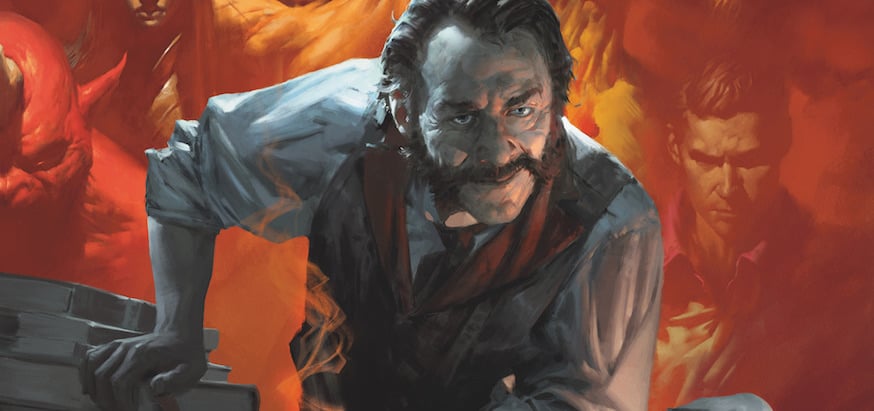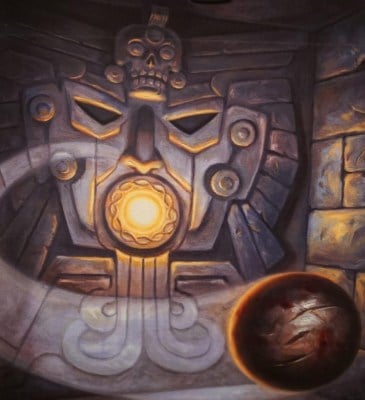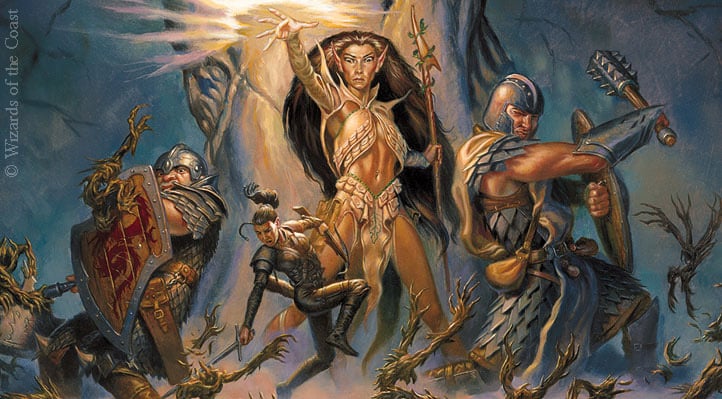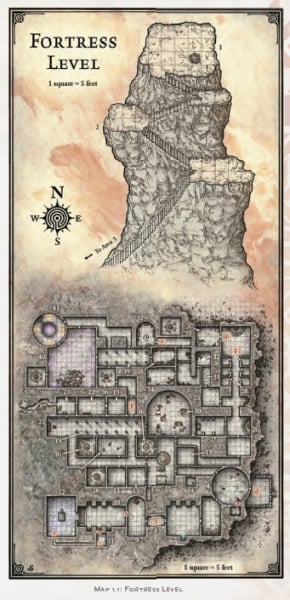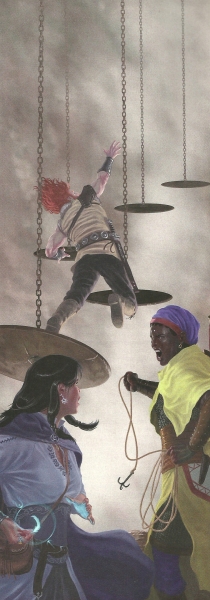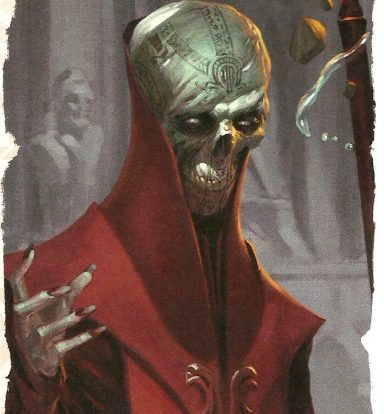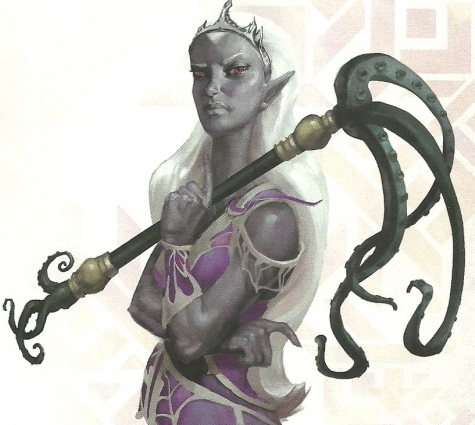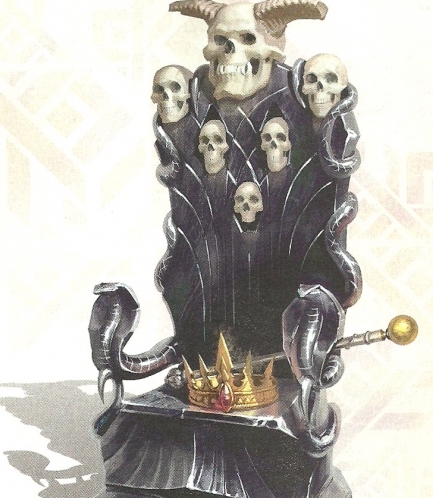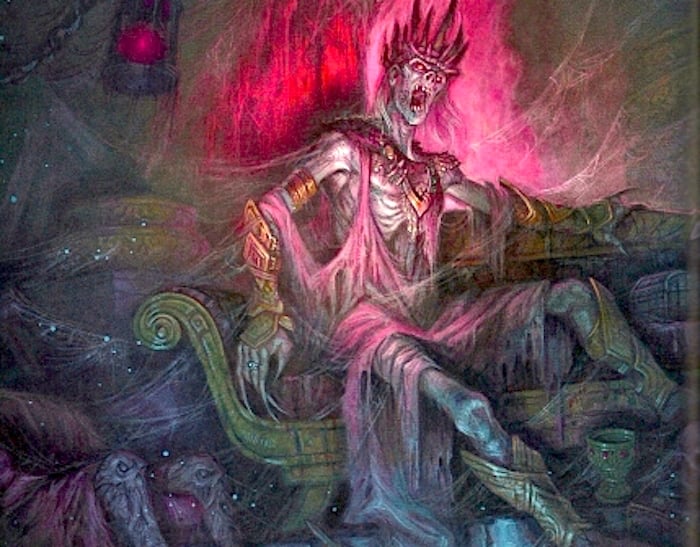D&D: Tales from the Yawning Portal Review


WoTC’s latest D&D book, Tales from the Yawning Portal, has been released (in select stores). Here’s our review
Tales from the Yawning Portal is many things. It’s a window to the past, a greatest hits album, and more importantly, a dungeon crawl extravaganza that manages to recapture that old school feel. Tales from the Yawning Portal comprises 7 dungeons from various eras throughout D&D’s history–all the way from classic modules like Tomb of Horrors and Against the Giants (written alongside the AD&D Player’s Handbook) to relatively recent releases like Dead in Thay, all updated to have 5th Edition rules.
Let’s get the ball rolling…
And when I say updated, I mean the monsters have been translated, and a few of the mechanics have been reworked, but these are otherwise as direct a translation as you could hope for. Reading through The Hidden Shrine of Tamoachan, or The Sunless Citadel, for instance is basically a word-for-word translation of the original–just with new balance to the mechanics. Some monsters are stronger, others are a little weaker, but for the most part these adventures feel just like their counterparts–White Plume Mountain still has the manic feel to it as they work to collect the intelligent weapons Wave, Whelm, and Blackrazor. The Tomb of Horrors still retains its legendary lethality–they’ve pulled no punches here, it even comes with a warning:
Only high-level characters stand a chance of coming back alive, but every player who braves the Tomb will have the experience of a lifetime.
And that’s pretty neat. It’s why this book is a retrospective of sorts. You can see how adventure design has changed over the last 43 years–your gaming group will get to walk through history.
The book lives or dies by the adventures contained within. Aside from the first four pages that give some lovely character to the book’s namesake inn, the only thing you’ll find here are the modules laid out chapter by chapter. And I think they couldn’t have picked a better seven.
Adventures
They start you with The Sunless Citadel, which if you’ve never played through it, was hailed as one of the best intro adventures that D&D’s produced. I tend to agree with this–it’s not necessarily the most original, but it provides a good suite of learning tools for GMs and Players alike. This adventure was written with “hey let’s help first time GMs” in mind, so there’s advice on how to run it–but also in the design of the adventure you get a good look at what solid adventure design can be.
In short: the characters are sent to explore the ruins of a sunken citadel that is overrun by goblins, kobolds, and worse… and at the heart of it lurks an evil druid and a tree sprouted from a stake through a vampire’s heart. If you’ve seen the Twig Blights out of the monster manual–this is where they were introduced.
There are four big areas to explore, there are maps that vary, the encounters feel different from fight to fight, and there’s a variety of encounter types. You get hard encounters, encounters where the monsters come in waves, or are spread out so the players have to move around. You get simple encounters with one or two twists that show up midfight. You get puzzle encounters–there’s a little bit of everything. If you are looking to get people into the game, or want a fun “tutorial” level, this module is a great start. It even culminates in a difficult boss fight–Belak and his bros mean business.
The Forge of Fury is next–this adventure is the followup to the Sunless Citadel (all of which were a part of the Ashardalon adventures–but that’s a story for another time). Characters are sent to a ruined dwarven fortress where they find monsters, duergar, dwarves, and dragons (the D section really gets a workout here). There are a number of “set-piece encounters” here that kind of show off how you can make dynamic encounters. There are fights over chasms, fights in furnace rooms, and so on. It’s a good example of how to amp up the threat (and, it culminates in a fight with a young dragon, so you get that very adventure-y feel towards the end).
For 5th level characters, the book has The Hidden Shrine of Tamoachan. We’ve talked about the Hidden Shrine of Tamoachan before–and it holds up. I love the zaniness of it. They really captured the feel of 1st Edition D&D with the monster updates. Say what you will about the deadliness of the Tomb of Horrors or the race through White Plume Mountain–Tamoachan is home to the best kinds of creatures. It shows off the creativity of the game–you’ll find a talking crayfish and his giant hermit crab buddy, both of whom can talk (and sing?!). There’s a giant slug (who can also talk), a mummified centaur–and through it all you get a glimpse into the Olman culture with artwork and murals (that are trapped or come to life to attack the players, naturally) and can play through a game with deadly consequences for those who lose.
There’s a lot packed into this adventure (packed into any of them) but this one is especially dense for how few pages it is–it’s a great example of classic dungeon crawl design. There’s no overarching plot, but just an exploration of a ruin with a purpose (even if it’s long forgotten and may never be discovered by the players).
8th level characters are ready to take on White Plume Mountain, which pits them against a dungeon designed and the mind of a mad wizard who taunts the adventurers but never makes an actual appearance. The adventurers are challenged to retrieve three legendary weapons, stolen from their secret vaults by Keraptis (the aforementioned insane mage), who–according to leged would be well over 1300 years by this point, so he’s probably definitely not the real Keraptis and just an impostor. But nevertheless players receive a note:
Search ye far or search ye near
You’ll find no trace of the three
Unless you follow instructions clear
For the weapons abide with me.North past forest, farm and furrow
You must go to the featheres mound
Then down away from the sun you’ll burrow
Forget life, forget light, forget sound.To rescue Wavem you must do battle
With the Beast in the Boiling Bubble
Crost cavern vast, where chain-links rattle
Lies Whelm, past water-spouts double.AdvertisementBlackrazor yet remains to be won
Underneath inverted ziggurat.
That garnered, think not that you’re done
For now you’ll find you are caught.I care not, former owners brave
What heroes you seek to hire.
Though mighty, I’ll make each one my slave
Or send him to the fire.
This was very much a Dungeon Crawl. The characters adventure to White Plume Mountain and walk through a series of creative encounters that are very much meant to evoke the sense of “A Wizard did it.” They’ll find things like a stream that floats in the air, with handy kayaks provided, because OF COURSE that’s what you’re going to do. Or they’ll come to a room they have to cross on disks and chains while geysers erupt all around them. And of course at the heart of it all are the legendary sentient weapons. Which just sort of shows some of the old pulp adventure mindset. The players are there for treasure, and the encounters are meant to be weird–they may feel a little disjointed at times, but are still interesting and fun. Playing through this dungeon is a lot like one of those obstacle game shows where the players have to do all kinds of crazy things for fortune and glory.
Dead in Thay was originally a 5th Edition module. Where the other dungeon crawls are about experiencing the locations, this one is definitely more of the “fun with a purpose” school of thought. It was originally a dungeon crawl for D&D Encounters, and was a playtest of the rules that became 5th Edition. Adventurers are sent to the Doomvault which holds the phylacteries of Szass Tam and all his lich friends. It is meant to be a lightning quick assault on the dungeon before guards and reinforcements can be summoned. A ton of fun–and you’re there to help facilitate Red Wizard infighting. Which is always good for a lark. But what I like about this dungeon is that it’s meant to keep the game moving–things get more and more hectic as the alert level of the Doomvault rises. It’s got good pacing, a narrative to it, and some fairly challenging encounters. This is a good benchmark of 5th-edition design philosophy in action.
5th Edition design philosophy: just add more liches. Which, you know, is always the right call.
Against the Giants is a classic for a reason. Three modules in one, Against the Giants is a saga that pits adventures against three different groups of giants, and their lairs–if you’ve played through Storm King’s Thunder, this is the adventure that inspired it. This was actually part of a series of adventures that had PCs chasing after a Drow priestess who was responsible for riling up the giants and getting them to attack human lands, visiting death and destruction upon all who they came across. And after the events of Against the Giants, players would go down into the Underdark and encounter Kuo-Toa for the first time ever, and other strange things besides.
This adventure is retooled for 11th level heroes, and uses all the updated giants from 5th edition, and I think it makes it stronger. There’s a mix of hard fights with many easy ones–you’ll spend a few sessions working through this module.
And finally there’s the Tomb of Horrors, the dungeon crawl Gary Gygax carried around in a briefcase in case someone started bragging about how their character could handle anything. It has a reputation for being a killer dungeon–and rightly so, there are many ways to die in it. But–this isn’t a bad thing. There are many places where it feels unfair–but these are good learning moments. It’s not about the dungeon playing nice, it’s about pitting yourself against it Dark Souls style until you finally start to figure it out and can get through.
And even if you make it to the end, you’ll still probably end up naked in the woods somewhere 300 miles away from where you started.
How does it Hold Up?
As mentioned, I like the selection of adventures. I think you get a solid mix of types–my one critique is that I wish they’d taken a little time to add some more of the 5th Edition philosophy to some of these dungeons. I get that you don’t need to remix everything, and I’m not saying these adventures are bad by any stretch–but I like 5th Edition’s narrative and mechanics in concert philosophy. It’s what made Volo’s Guide stand out so much–this one feels like it leans a little more on Nostalgia. It wouldn’t even have to be much–just some extra character to the sometimes dry modules–after a while moving from one encounter to another can feel like a bit of a slog. And part of that is definitely reading through them all in one sitting for this review–even so, I think the 5th Edition team has done a good job of bringing out flavor in their other books. I’d like to have seen a little more of that here.
Look all I’m asking is, what’s this guy’s motivation… is that so wrong?
But that said, I think they did a great job with the book. The encounters are balanced, the adventures are all wonderful examples of various kinds of dungeon crawls–and that’s half of the name of the game here.
Should you pick it up? Well, at $49.99 it’s about what you’d expect to pay for a hardcover D&D book. And with 7 modules, that’s about $7.14 per module, which is a pretty good price. I think it’s definitely worth it. But you’ll want to keep in mind what it is. It’s not the next big storyline from WoTC, nor is it a tool like Volo’s Guide, but it is a wonderful collection of dungeons.
And that’s the way the book is meant to be used. It’s a collection of dungeons that you can drop into your own campaign–you could also take the time to craft a little story that connects these encounters, but it’s not an adventure path or campaign book. It’s there for your characters to find these places in the world and explore them.
I think you can make your world a little richer by dropping these dungeons into it. Figuring out how they fit in your campaign is a great challenge–it reminded me of one of the parts of Baldur’s Gate II, when you are exploring and would randomly find dungeon encounters–I think dropping these into your world map is a great way to use them.
So with that in mind, I’d say yeah, pick it up and have fun. I think it’ll add (or remind your players of) that “hey let’s explore the world” feel to your campaign.
And besides, any book that features a talking crustacean gets a pass–and this book has several…

